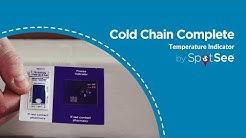How to Monitor Temperature in Cold Chain Logistics

Cold chain monitoring is essential to ensure the quality and potency of sensitive products. Modern temperature tracking solutions for the cold chain logistics industry provides supply chain managers with the data and proof they need to get temperature-sensitive products from point A to point B — and everywhere in between. This data also allows managers to optimize their cold chain logistics by finding gaps and problem areas.
Cold Chain Logistics: Essential Supply Chains
Cold chain refers to the channel that temperature-sensitive products take from production to the end-user. Such items include food, beverages, horticultural products, lab specimen, vaccines, pharmaceuticals, and chemicals. The cold chain encompasses all products that require temperature management, whether by cooling or warming.
Cold chain businesses face many risks that necessitate temperature monitoring. There are also government and industry regulations that stakeholders in the supply chain have to follow.
Risks and Dangers in Cold Chain Logistics
A single incident of unfavorable temperature is enough to ruin a whole inventory of perishable heat-sensitive goods. Some risks that would cause such events in cold chain logistics include:
● Extended power interruptions
● Refrigerator or freezer breakdown
● Human error, like incorrectly packaging a product for shipment
● Temperature events occurring outside business hours
● Lack of infrastructure to monitor and report incidents
Why are these risks such a big deal? Because of the documented history of the problems they cause, and the widespread nature of the risk. Not only can cold chain failures be costly and disruptive, they can be downright dangerous to consumers.

In 2017, the global cold chain industry spent $13.4 billion exclusively on biopharmaceutical products. Unfortunately, 20% to 40% of the items got damaged before reaching consumers. The Centers for Disease Control (CDC) has found a sixth of the American population to fall ill each year due to food-related diseases. Another study suggests that 40% of food wastage in North America results from deficiencies in the supply chain, improper storage being a contributing factor.
Cold Chain Logistics Compliance Requirements
Food and drug manufacturers understand the need to operate within industry regulatory standards. The problem is that there isn’t an international standard for acceptable distribution practices. Various jurisdictions have different policies and levels of compliance. Additionally, regional compliance mandates are always evolving, making compliance more complicated.
Below are some regulatory requirements for ensuring product quality and consumer safety:
Food Safety Modernization Act (FSMA)
FSMA, a food safety act in the United States, came into law in 2011. It requires supply chains to prevent food contamination proactively instead of responding to incidents. According to this law, food and beverage manufacturers must log and document the whole temperature history of their products.
It sounds daunting, but it can be done easier than you think.
Hazard Analysis and Critical Control Points (HACCP)
Another best practice cold chain businesses should adhere to is HACCP. It emphasizes measurement and documentation of parameters to prevent hazards instead of reactive measures like product recalls.
How to Combat Temperature Hazards in Cold Chains
Temperature data loggers can help alleviate incidents of product deterioration due to temperature fluctuations. We can classify data loggers (or data monitors) into two groups based on how they work.
Temperature Indicators
These inexpensive devices provide an alert when temperatures are below or above a preset range. Typically, they change color, say from white to red when exposed to potentially damaging temperature levels. They indicate but store no data. They provide proof that an asset did or did not experience temperature excursions.

WarmMark is an easy-to-use time-temperature indicator by SpotSee that notifies handlers about adverse temperatures. Its sensitivity ranges between 0°F and 99°F. WarmMark is suitable for many cold chain monitoring applications, including shipping food items, chocolate, flowers, test specimens, medicine, and more. If the package gets too warm — rises above the preset threshold — the indicator tells you that it did, and for how long, so you can gauge the affect on the product.
WarmMark is also available in a purpose-built COVID-19 TempControl package for test kits and vaccine shipments.
Variations of this temperature indicator include WarmMark Duo, with dual temperature monitoring thresholds, and WarmMark Long Run, with an extended time measurement of up to 168 hours.

Inversely, temperature indicators such as ColdMark shows visual indication if an asset has dropped below the preset temperature threshold. This means it could have been susceptible to freeze-related damage.

For a Goldilocks product — one that must be kept not-too-hot and not-too-cold, Cold Chain Complete provides a dual hot/cold indicator.
Temperature Recorders
A temperature recorder is more sophisticated than a temperature indicator, for when continuous temperature tracking is needed.
It also features one or more connectivity technologies to help transmit or retrieve stored data. The mode of transmission can be Bluetooth, USB, RFID, or cellular. Be sure to check the pros of different connectivity options to select the right temperature recorder for your business.

The LOGIC temperature data logger is a low-cost temperature recorder for cold chain applications. It alerts manufacturers and shippers when products get exposed to temperatures beyond the acceptable limits. The unit features integrated wireless connectivity with semi-passive RFID and USB to ease data downloads. It can store up to 4,000 data points and has a battery life of up to three years.
Take Control of Your Cold Chain Logistics with the Right Cold Chain Monitors
SpotSee supports cold chain logistics managers with the right products, from affordable, single-use indicators to full featured data loggers. To find the right temperature monitoring solution for your unique cold chain logistics needs, fill out the form below to setup a cold chain monitoring consultation.







